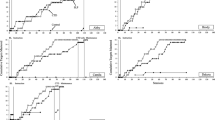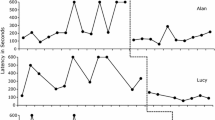Abstract
This preliminary study compared brief (1 s) and extended (4 s) wait-time on response opportunities, academic responses, accuracy, and disruptive behavior of two children with challenging behavior during small group instruction. Brief wait-time increased children’s response opportunities, academic responses, and accuracy in comparison to extended wait-time. Though variable, brief wait-time also decreased children’s disruptive behavior. Findings differ from previous research, which found performance improvements with extended wait-time for children with moderate to profound cognitive disabilities. Limitations of the study and future research suggestions are discussed.



Similar content being viewed by others
References
Brown, L. L., & Hammill, D. D. (1990). Behavior rating profile: An ecological approach to behavioral assessment. Austin, TX: Pro-ed, Inc.
Carnine, D. W. (1976). Effects of two teacher presentation rates on off-task behavior, answering correctly, and participation. Journal of Applied Behavior Analysis, 9, 199–206.
Carlin, M. T., Soraci, S., Goldman, A. L., & McIlvane, W. (1995). Visual search in unidimensional arrays: A comparison between subjects with and without mental retardation. Intelligence, 21, 175–196.
Cooper, J. O., Heron, T. E., & Heward, W. L. (1987). Applied behavior analysis. Columbus: Merrill.
Darch, C., & Gersten, R. (1985). The effects of teacher presentation rate and praise on LD students’ oral reading performance. British Journal of Educational Psychology, 55, 295–303.
Duker, P. C., Van Doeselaar, C., & Verstraten, A. (1993). The effect of response delay on correct responding to instructions during communicative gesture training. Education & Training in Mental Retardation, 28, 327–332.
Dunlap, G., Clarke, S., Jackson, M., & Wright, S. (1995). Self-monitoring of classroom behaviors with students exhibiting emotional and behavioral challenges. School Psychology Quarterly, 10, 165–177.
Dunlap, G., Dyer, K., & Koegel, R. L. (1983). Autistic self-stimulation and intertrial interval duration. American Journal of Mental Deficiency, 88, 194–202.
Dyer, K., Christian, W. P., & Luce, S. C. (1982). The role of response delay in improving the discrimination performance of autistic children. Journal of Applied Behavior Analysis, 15, 231–240.
Engelmann, S., & Osborn, J. (1999). Language for Learning teacher’s guide. Columbus, OH: SRA/McGraw-Hill.
Falk, K. B., & Wehby, J. H. (2001) The effects of peer-assisted learning strategies on the beginning reading skills of young children with emotional or behavioral disorders. Behavioral Disorders, 26, 344–359.
Good, T. L., & Brophy, J. (2003). Looking in classrooms (9th ed.). Boston: Pearson Education.
Gresham, F. M., Cook, C. R., Crews, S. D., & Kern, L. (2004). Social skills training for children and youth with emotional and behavioral disorders: Validity considerations and future directions. Behavioral Disorders, 30, 32–46.
Heward, W. L. (1994). Three “low-tech” strategies for increasing the frequency of active student response during group instruction. In R. Gardiner III, D. M. Sainato, J. O. Cooper, T. E. Heron, W. L. Heward, J. Eshleman, & T. A. Grossi (Eds.), Behavior analysis in education: Focus on measurably superior instruction (pp. 283–320). Pacific Grove, CA: Brooks/Cole.
Kauchak, D. K., Eggen, P., & Carter, C. (2002). Introduction to teaching: Becoming a professional. Upper Saddle River, NJ: Merrill/Prentice Hall.
Kauffman, J. M. (2004). Characteristics of emotional and behavioral disorders of children and youth (8th ed.). Upper Saddle River, NJ: Pearson/Merrill Prentice Hall.
Kennedy, C. H. (2005). Single case designs for educational research. Boston: Pearson Education.
Koegel, R. L., Dunlap, G., & Dyer, K. (1980). Intertrial interval duration and learning in autistic children. Journal of Applied Behavior Analysis, 13, 91–99.
Lee, J., O’Shea, L. J., & Dykes, M. K. (1987). Teacher wait-time: Performance of developmentally delayed and non-delayed young children. Education & Training in Mental Retardation, 22, 176–184.
Lowry, P. W., & Ross, L. E. (1975). Severely retarded children as impulsive responders: Improved performance with response delay. American Journal of Mental Deficiency, 80, 133–138.
Nelson, J. R, Benner, G. J., Lane, K., & Smith, B. W. (2004). Academic achievement of K-12 students with emotional and behavioral disorders. Exceptional Children, 71, 59–73.
Rosenberg, M. S., Wilson, R., Maheady, L., & Sindelar, P. T. (2004). Educating students with behavior disorders (3rd ed.). Englewood Cliffs, NJ: Prentice-Hall.
Rowe, M. B. (1974). Wait-time and rewards as instructional variables, their influence on language, logic, and fate control. Part one. Wait-time. Journal of Research in Science Teaching, 11, 81–94.
Rowe, M. B. (1987). Wait time: Slowing down may be a way of speeding up. American Educator, 11, 38–43.
Skinner, C. H., Smith, E. S., & McLean, J. E. (1994). The effects of intertrial interval duration on sight-word learning rates in children with behavioral disorders. Behavioral Disorders, 19, 98–107.
Sutherland, K. S., & Wehby, J. H. (2001). Exploring the relationship between increased opportunities to respond to academic requests and the academic and behavioral outcomes of students with EBD: A review. Remedial and Special Education, 22, 113–121.
Tobin, K. (1987). The role of wait time in higher cognitive level learning. Review of Educational Research, 57, 69–95.
Tincani, M., Ernsbarger, S., Harrison, T. J., & Heward. W. L. (2005). Effects of two instructional paces on pre-K children’s participation rate, accuracy, and off-task behavior in the Language for Learning Program. Journal of Direct Instruction, 5, 97–109.
Valcante, G., Roberson, W., Reid, W. R., & Wolking W. D. (1989). Effects of wait-time and intertrial interval durations on learning by children with multiple handicaps. Journal of Applied Behavior Analysis, 22, 43–55.
Waldron-Soler, K. M., & Osborn, J. (2004). Language. In N. E. Marchand-Martella, T. A. Slocum, & R. C. Martella (Eds.), Introduction to Direct Instruction (pp. 66–99). Boston: Pearson/Allyn and Bacon.
Acknowledgements
The authors wish to thank Sue Germeroth and her staff for their support.
Author information
Authors and Affiliations
Corresponding author
Rights and permissions
About this article
Cite this article
Tincani, M., Crozier, S. Comparing Brief and Extended Wait-Time During Small Group Instruction for Children with Challenging Behavior. J Behav Educ 17, 79–92 (2008). https://doi.org/10.1007/s10864-008-9063-4
Published:
Issue Date:
DOI: https://doi.org/10.1007/s10864-008-9063-4




